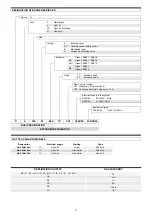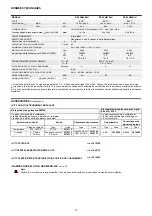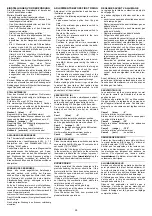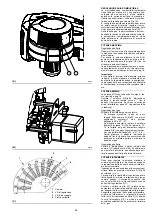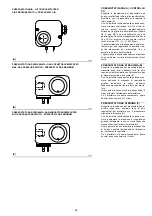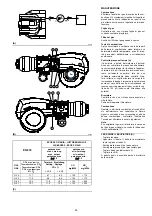
23
GASZULEITUNG (A)
Die Gasarmaturen können mit dem Flansch
1)(A) rechts am Brenner angebracht werden.
Sollte es notwendig sein, sie links am Brenner
anzubringen, Muttern und Schrauben 3) und 4)
losschrauben, den Blindflansch 2) und die jew-
eilige Dichtung entfernen und diese an Flansch
1) anbringen und Muttern und Schrauben
wieder montieren.
Anmerkung
Nach der Montage der Gasarmaturen muss
geprüft werden, dass keine Undichtheiten
vorhanden sind.
GASARMATUREN (B)
Nach Norm EN 676 typgeprüft, wird gesondert
mit dem in Tab. (C) angegebenen Code
geliefert.
ZEICHENERKLÄRUNG SCHEMA (B)
1 - Gaszuleitung
2 - Handbetätigtes Ventil
3 - Kompensator
4 - Manometer mit Druckknopfhahn
5 - Filter
6 - Druckregler
(senkrecht)
7 - Gas-Minimaldruckwächter
8 - Sicherheitsmagnetventil VS
(senkrecht)
9 - Kit Druckwächter für Dichtheitskontrolle
gesondert mit dem in Tab. (C) angege-
benen Code geliefert. Laut Norm EN 676 ist
die Dichtheitskontrolle für Brenner mit Höch-
stleistung über 1200 kW Pflicht.
10- Regelmagnetventil VR
(senkrecht)
Zwei Einstellungen:
- Zünddurchsatz
(schnellöffnend)
- Höchstdurchsatz
(langsamöffnend)
11- Passtück Armatur-Brenner.
12- Dichtung und Flansch Brenner-
grundausstattung
13- Gas-Einstelldrossel
14- Brenner
P1- Gasdruck am Flammkopf
P2- Druck nach dem Regler
P3- Druck vor dem Filter
P4- Luftdruck am Flammkopf
L - Gasarmatur gesondert mit dem in Tab. (C)
angegebenen Code geliefert.
L1- Vom Installateur auszuführen.
WICHTIG
Der Druck am Brennerkopf (M2) in Tabelle (D)
bezieht sich auf einen Wert von Null in der
Brennkammer; für den Istdruck, mit einem U-
Manometer gemessen (siehe Abb. A Seite 24),
den Heizkesselgegendruck addieren.
Merke
Zur Einstellung der Gasarmaturen siehe die
beigelegten Anleitungen.
GAS LINE (A)
The gas train is to be connected on the right of
the burner, by flange 1) (A).
If it is necessary to connect it on the left of the
burner, loosen nuts and screws 3) and 4),
remove blind flange 2) together with its gasket
and fit them to flange 1) tightening the nuts and
screws.
Note
Once assembled the gas train, check for leaks.
GAS TRAIN (B)
It is type-approved according to EN 676 Stand-
ards and is supplied separately from the burner
with the code indicated in Table (C).
KEY TO LAYOUT (B)
1 - Gas input pipe
2 - Manual valve
3 - Vibration damping joint
4 - Pressure gauge with pushbutton cock
5 - Filter
6 - Pressure governor
(vertical)
7 - Minimum gas pressure switch
8 - Safety solenoid VS
(vertical)
9 - Pressure switch kit for leak detection con-
trol, supplied separately with the code indi-
cated in Table (C). In accordance with EN
676 Standards, gas valve leak detection
control devices are compulsory for burners
with maximum outputs of more than 1200
kW.
10- Adjustment solenoid VR
(vertical)
Two adjustments:
- ignition delivery
(rapid opening)
- maximum delivery
(slow opening)
11- Gas train/burner adaptor.
12- Standard issue burner gasket with flange
13- Gas adjustment butterfly valve
14- Burner
P1- Gas pressure at combustion head
P2- Pressure down-line from the pressure gov-
ernor
P3- Pressure up-line from the filter
P4- Air pressure at combustion head
L - Gas train supplied separately with the code
indicated in Table (C).
L1- The responsability of the installer.
IMPORTANT
The pressure at the head of the burner (M2) -
from table (D) - refers to zero in the combustion
chamber; to obtain true pressure, measured by
a U-type manometer, (see fig. (A) page 24) add
the counter-pressure of the boiler.
Note
See the accompanying instructions for the
adjustment of the gas train.
LIGNE ALIMENTATION GAZ (A)
La rampe gaz est prévue pour être reliée à la
droite du brûleur, à l»aide de la bride 1)(A).
S»il est nécessaire de la relier à gauche,
dévisser les écrous et les vis 3) et 4), enlever la
bride borgne 2) ainsi que le joint correspondant
et les appliquer à la borne 1) en remontant les
écrous et les vis.
Remarque
Vérifier s»il n»y a pas de fuites après avoir monté
la rampe.
RAMPE GAZ (B)
Elle est homologuée suivant la norme EN 676 et
elle est fournie séparément du brûleur avec le
code indiqué dans le tableau (C).
LEGENDE SCHEMA (B)
1 - Canalisation d'arrivée du gaz
2 - Vanne manuelle
3 - Joint anti-vibrations
4 - Manomètre avec robinet à bouton poussoir
5 - Filtre
6 - Régulateur de pression
(vertical)
7 - Pressostat gaz de seuil minimum
8 - Electrovanne de sécurité VS
(verticale)
9 - Kit pressostat pour le contrôle de
l»étanchéité, fournie à part avec le code
indiqué dans le tab. (C). Selon la norme EN
676, le contrôle d'étanchéité est obligatoire
pour les brûleurs ayant une puissance max-
imale supérieure à 1200 kW.
10- Electrovanne de régulation VR
(verticale)
Deux réglages:
- débit d'allumage
(ouverture rapide)
- débit maxi
(ouverture lente)
11- Adaptateur rampe-brûleur.
12- Joint et bride fournis avec le brûleur
13- Papillon réglage gaz
14- Brûleur
P1- Pression gaz à la tête de combustion
P2- Pression en aval du régulateur
P3- Pression en amont du filtre
P4- Pression air à la tête de combustion
L - La rampe gaz est fournie à part avec le
code indiqué dans le tab. (C).
L1- A la charge de l'installateur
IMPORTANT
La pression à la tête du brûleur (M2, tableau D)
se réfère à zéro dans la chambre de combus-
tion; pour obtenir la pression réelle, mesurée
avec un manomètre en U (voir fig. A page 24),
ajouter la contre-pression de la chaudière.
Note
Pour le réglage de la rampe gaz voir les instruc-
tions qui l'accompagnent.
Содержание RS 300/M BLU
Страница 2: ......
Страница 41: ...41...
Страница 42: ...42...
Страница 43: ...43...
Страница 44: ...44...
Страница 45: ...45...
Страница 46: ...46...
Страница 47: ...47...
Страница 48: ...48...
Страница 49: ...49...
Страница 50: ...50...
Страница 51: ...51...
Страница 52: ...52...
Страница 55: ......

